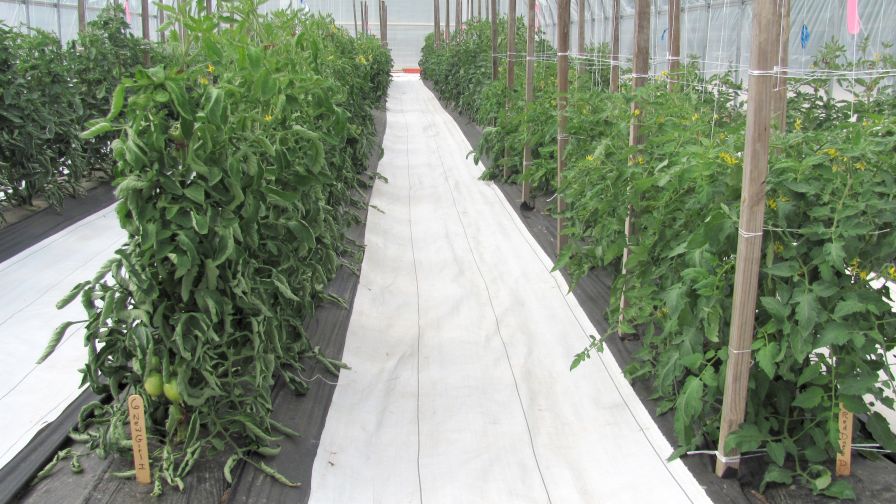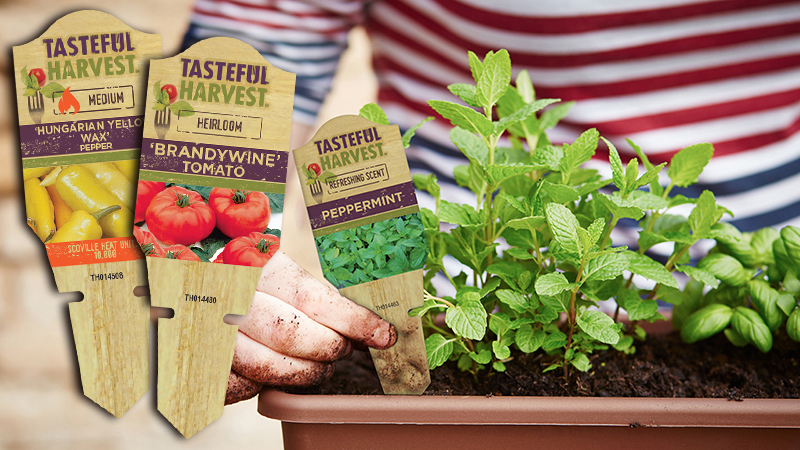Cultural and Chemical Options for Managing Diseases in Greenhouse Tomatoes

This photo shows a white, reusable ground cover that can help prevent crop debris from entering the soil, reduce weed pressure, and allow the greenhouse floor to be easily swept. Photo: Daniel Egel, Shubin Saha
Editor’s Note: This is the second of a two-part series on greenhouse tomato diseases. The first part, which focused on the most common diseases, can be found here.
Rotating out of tomato or related solanaceous crops for three to four years will help to control most tomato diseases. However, many vegetable growers who operate greenhouses find it economically impractical to rotate away from tomatoes.
If one chooses to grow tomatoes after tomatoes without crop rotation, disease management may be improved by removing as much of the tomato plant as possible from the greenhouse and away from all potential production areas as soon as the crop is finished in the late summer or fall. To further reduce the amount of crop residue that enters the soil between tomato crops, you can place a cloth ground covering between each row. Such a ground cover will help prevent the buildup of crop residue that might contain plant disease microbes from entering the soil. It also helps eliminate weeds and allows the greenhouse to be easily swept.
The white ground cover rests on top of black landscape cloth, making the ground cover easy to clean and reuse. While the white ground cover can be washed, sanitized, and reused next season, the black landscape cloth is not reuseable. Note that the white ground cover can reflect light into the canopy to maximize solar radiation; however, black ground covers are also used effectively.
Greenhouse Ventilation
In general, any practice that reduces relative humidity and moisture will reduce the severity of diseases in greenhouse tomatoes. The following practices can help with greenhouse ventilation.
- Ventilate the greenhouse in the evening with relatively dry air when possible. When cool temperatures are a concern, such as in high tunnels where heating is passive, it becomes important to close the structure before dusk to allow heat to build up before temperatures start to drop. This practice traps heat to avoid overnight cold damage. However, once cool temperatures are no longer a concern, ventilate the greenhouse at dusk so that the drier air from outside may replace humid air inside the greenhouse.
- Plant spacing can vary, but a good starting point would be rows spaced 4 to 5 feet apart and 20 to 24 inches between plants within the row. Placing too many tomato plants in a high tunnel may restrict airflow and increase humidity. In addition, research has shown that placing tomatoes closer than about 20 inches within a row on 5-foot centers decreases fruit size.
- Prune tomato plants to facilitate airflow. This is especially useful with indeterminate tomato varieties. Avoid pruning too much material at any one time. As a general rule, leave indeterminate tomatoes with at least 18 to 20 fully mature leaves after pruning. Determinate tomato plants are often pruned until the first flower cluster, improving airflow and encouraging larger tomato fruit.
- To further reduce humidity and leaf wetness in greenhouses, use appropriate air circulation fans. The placement and number of fans depends on the volume of air within the structure.
Fungicide Use
Fungicides can help to reduce the severity of diseases in greenhouse tomatoes. However, fungicides are no substitute for good management practices. Consult your state Extension service for publications that provide the most current fungicide recommendations. Always read and follow labels carefully.
Here is a general overview of fungicides, listed by the active ingredient, that are labeled and effective for several greenhouse tomato diseases. Fungicides that may be certified in organic agriculture are listed as bullet points following each number.
- Botrytis gray mold. 2, 6 – dichloro-4-nitroanaline, copper, mancozeb, penthiopyrad, pyrimethanil, and cyprodinil/fludioxanil.
- Regalia; Cease + Milstop; Oxidate; copper
- Leaf mold. copper, mancozeb, difenconazole/ cyprodinil, difenconazole/mandipromid, and cymoxanil/famoxadone.
- Actinovate AG; Double Nickel; Copper; Oxidate
- White mold (timber rot) -no conventional fungicides are listed for use in a greenhouse.
- Howler
Here are some additional items on diseases in greenhouse tomatoes to consider when selecting a product from the above list:
- Carefully note the re-entry interval (REI) and preharvest interval (PHI). Some products may have intervals sufficiently long to restrict their use to early season. In particular, mancozeb products and 2, 6 – dichloro-4-nitroanaline have relatively long PHIs.
- Copper and mancozeb products are contact fungicides. The remaining conventional products are systemic and will move within the plant after application.
- Not all fungicides are labeled for greenhouse use. Check the label for warnings against greenhouse use. In addition, state regulations may differ on greenhouse use of fungicides-check with your state chemist or Extension service.










